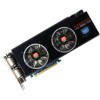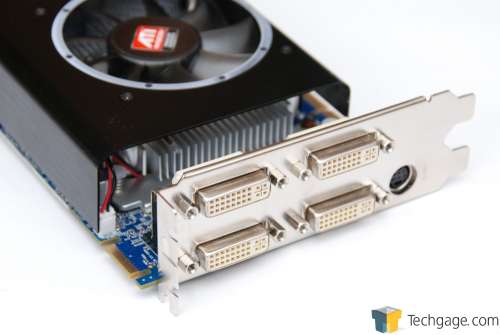- Qualcomm Launches Snapdragon 4 Gen 2 Mobile Platform
- AMD Launches Ryzen PRO 7000 Series Mobile & Desktop Platform
- Intel Launches Sleek Single-Slot Arc Pro A60 Workstation Graphics Card
- NVIDIA Announces Latest Ada Lovelace Additions: GeForce RTX 4060 Ti & RTX 4060
- Maxon Redshift With AMD Radeon GPU Rendering Support Now Available
Sapphire Radeon HD 4850 X2 2GB

If you game at ultra-high resolutions and want to know where the best bang for the buck can be found in graphics cards, look no further than Sapphire’s dual-GPU HD 4850 X2. At $300, it’s priced-right and offers incredible performance regardless of whether you prefer high anti-aliasing settings or resolutions.
Page 1 – Introduction, Closer Look
When ATI released their stellar HD 4000 series this past summer, the first question we had to ask was, “Where’s the duals?” Indeed, their launch cards took everyone by surprise, including NVIDIA, so to imagine two such GPUs on one card sounded very drool-worthy. Luckily, we didn’t have to wait too long to be treated to the first X2 of the 4000 series.
In August, when the HD 4870 X2 was released, we didn’t know much about the HD 4850 X2 and it’s no surprise. The HD 4870 X2 offered incredible performance and became a popular choice for high-end gamers, so it’s easy to see why ATI didn’t want to follow-up with a lesser-performing and lesser-expensive card too quickly.
But, that wait lasted only a few months, and we were greeted by the first HD 4850 X2 on the market this past November, courtesy of Sapphire. I’m unsure of the reasoning behind it, but Sapphire is the only manufacturer to offer such a model. I assume this was thanks to an exclusive partnership with ATI, and partially because not too many other companies were keen on releasing the model themselves. This is what I have gathered from talking to certain vendors in the past few months.
So was the wait worth it? As we’ll see today, it definitely was. Though we are posting this two months after the initial release, the card proves to be just as relevant today as it was in November. As it stands, the HD 4850 X2 retails for around $300, and at that price-point, it’s only a bit more expensive than NVIDIA’s GTX 260/216. ATI themselves don’t have another card of their own priced in the same range. The next-step downward would be the HD 4870 1GB, at around $250, followed by the HD 4870 512MB at $200.
Closer Look
There’s not too much to touch on regarding this card, as nothing is truly new in way of its inner-workings. Like the HD 4870 X2, this is a single-PCB offering with two 55nm GPUs placed down. This is dissimilar to NVIDIA’s dual-GPU offerings which use dual-PCB, even with their upcoming GTX 295. ATI’s build solution seems more sensible than NVIDIA’s. The resulting card is lighter, and likely draws less power, GPUs themselves aside.
Like its little brother, the HD 4850 X2 features a 625MHz clock per GPU, and 2GB worth of GDDR3 running at 993MHz. The HD 4870 runs faster GDDR5, so aside from general clock boosts, the HD 4870 X2 has other performance improvements as well. But given the HD 4850 is a monster card to begin with, we might see that sticking with GDDR3 isn’t going to effect much.
|
Model
|
Core MHz
|
Mem MHz
|
Memory
|
Bus Width
|
Stream Proc.
|
| HD 4870 X2 |
750
|
900
|
2x1024MB
|
256-bit
|
800
|
| HD 4850 X2 |
625
|
993
|
2x1024MB
|
256-bit
|
800
|
| HD 4870 |
750
|
900
|
512MB
|
256-bit
|
800
|
| HD 4850 |
625
|
993
|
512MB
|
256-bit
|
800
|
| HD 4670 |
750
|
900
|
512MB
|
128-bit
|
320
|
| HD 4650 |
600
|
500
|
512MB
|
128-bit
|
320
|
| HD 3870 X2 |
825
|
900
|
2x512MB
|
256-bit
|
320
|
| HD 3850 X2 |
666
|
828
|
2x512MB
|
256-bit
|
320
|
| HD 3870 |
775
|
900
|
512MB
|
256-bit
|
320
|
| HD 3850 |
666
|
828
|
512MB
|
256-bit
|
320
|
| HD 3650 |
725
|
800
|
256,512MB
|
128-bit
|
120
|
| HD 3450 |
600
|
500
|
256MB
|
64-bit
|
40
|
Given that Sapphire is the only producer of these cards, it’s no surprise that they wanted to go the extra mile to deliver a card that was actually worthwhile. Their offering features a unique-looking cooler that maximizes airflow. The black shroud is light and lifts off with the removal of eight small screws.
The included fans are both quiet and good-looking. The general design is somewhat similar to Palit’s dual-fan HD 4870 Sonic Edition that we took a look at back in October. That card impressed us with its great cooling-ability, so we’re hoping this card will deliver similar results.
Like the rest of the current ultra-high-end GPU offerings, this one also requires a PSU with two PCI-E power connectors, one of which must be 8-pin. Given the power draw of the card, you’ll want to make sure you have a competent power supply, and that point is even stronger if you plan on going Quad-GPU.
Aside from the cooler, what else sets this card apart? Looking at the below image, chances are you won’t have to ask. Although the scenario where someone has four monitors is going to be rare, the option is at least here for those who need it. I do wish that instead of four DVIs, that we’d see two DVI’s and then an HDMI and DisplayPort, though. I’d imagine that the situation where someone would need either one of those special ports would come long before someone would need four DVIs.
Below, you can see the inner-workings of the card. As mentioned before, the cooler is optimized for airflow, and that much is evident when taking off the shroud. The unique heatsink design allows efficient heat-dissipation and overall, the card is physically much lighter than the reference-designed HD 4870 X2.
With that look out of the way, let’s take care of our testing methodology, and then we’ll get right into our results with Crysis Warhead.
Support our efforts! With ad revenue at an all-time low for written websites, we're relying more than ever on reader support to help us continue putting so much effort into this type of content. You can support us by becoming a Patron, or by using our Amazon shopping affiliate links listed through our articles. Thanks for your support!









